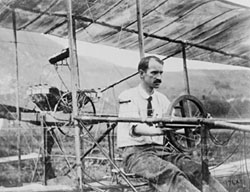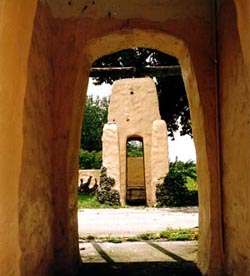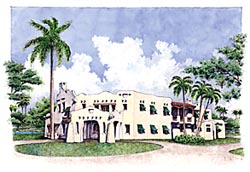
The Glenn Curtiss House was constructed in 1925 for this aviation pioneer who had established his own airplane company before becoming the developer of Miami Springs, Florida. Located in his Miami Spring development, Curtiss lived in this large, two-story residence designed in the Pueblo Revival style until his death in 1930. Glenn Hammond Curtiss, born in 1878 in Hammondsport, New York, was a rival of the Wright Brothers. Like the Wright Brothers, Curtiss was interested in bicycles as a young man, opening a bicycle repair shop in 1900 after his marriage to Lena Pearl Neff. Interested in speed, he soon turned to motorcycles and designed a machine with a lightweight, high-power engine. He created the G.H. Curtiss Manufacturing Company in New York in 1902, and began producing the Hercules motorcycle. Although setting records for motorcycle racing, his company also drew the attention of aeronautical experimenters--in July 1904 Thomas Scott Baldwin used a Curtiss two-cylinder engine to power the first successful dirigible to fly in the United States, the California Arrow.
Alexander Graham Bell, the famed inventor, was also impressed by the Curtiss engines, and invited Curtiss to join the Aerial Experiment Association (AEA). Curtiss turned to airplanes after Bell's man-carrying motorized kite was deemed a failure. The AEA designed and built several airplanes, including the Red Wing which first flew on March 12, 1908. This was followed two months later by the White Wing, which employed Bell-contrived ailerons for lateral control, a system that was superior to the wing warping used by the Wright Brothers. Curtiss became an enthusiastic flyer, and after the AEA disbanded in 1909, established his own airplane company in Hammondsport, New York. The second airplane company that Curtiss established, the Curtiss Aeroplane Company, became the world's largest aircraft manufacturer during the war. He developed an airplane that could land on water for the Navy, but he soon found himself in a legal battle with the Wright Brothers, who held a patent on their wing-warping system. While the Wrights won in court, Curtiss paid no penalty, and a Wall Street syndicate formed the Curtiss Aeroplane & Motor Company, with Curtiss as president. The most widely produced model during World War I was Curtiss's JN-4 "Jenny." When the company underwent major financial reorganization in 1920, Curtiss moved to southern Florida, where he became a real estate developer during the 1920s. As William M. Leary wrote in American National Biography, "Curtiss stands in the forefront of American aeronautical pioneers, second only to the Wright brothers in historical significance."

The Glenn Curtiss House is one of the largest and most architecturally distinguished of the Pueblo Revival residences associated with Curtiss's Miami Springs development. Its architect, Martin Luther Hampton, was one of Miami's most prominent architects during the 1920s--his designs include the former Miami Beach City Hall and the Congress Building in downtown Miami. The house is roughly V-shaped in plan and constructed of hollow clay tile with a rough textured stucco exterior. The roof is flat with very irregular parapet walls embellished by projecting waterspouts and irregular shaped openings. The main entrance to the residence is set within a deeply recessed T-shaped opening and marked by a flat-roofed porte cochere. The southeast central courtyard of the building features a later oolithic (rock consisting of small round grains) limestone facing on its first story pierced by modern windows and glass doors.

After Glenn Curtiss's death in the early 1930s, Lena Curtiss married an old friend and business associate of her husband, H. Sayre Wheeler. Wheeler served as mayor of Miami Springs from 1942 to 1944 and was also part owner of the Michaels and Wheeler Insurance Company. The couple lived in the house until the late 1940s. It was subsequently converted into the Miami Springs Villas House in 1953.
Visit the National Park Service Travel American Aviation to learn more about Aviation related Historic Sites.
Last updated: September 3, 2017
